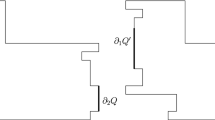Abstract
We introduce a new class of bootstrap percolation models where the local rules are of a geometric nature as opposed to simple counts of standard bootstrap percolation. Our geometric bootstrap percolation comes from rigidity theory and convex geometry. We outline two percolation models: a Poisson model and a lattice model. Our Poisson model describes how defects--holes is one of the possible interpretations of these defects--imposed on a tensed membrane result in a redistribution or loss of tension in this membrane; the lattice model is motivated by applications of Hooke spring networks to problems in material sciences. An analysis of the Poisson model is given by Menshikov et al. (4) In the discrete set-up we consider regular and generic triangular lattices on the plane where each bond is removed with probability 1−p. The problem of the existence of tension on such lattice is solved by reducing it to a bootstrap percolation model where the set of local rules follows from the geometry of stresses. We show that both regular and perturbed lattices cannot support tension for any p<1. Moreover, the complete relaxation of tension--as defined in Section 4--occurs in a finite time almost surely. Furthermore, we underline striking similarities in the properties of the Poisson and lattice models.
Similar content being viewed by others
REFERENCES
R. H. Schonmann, Critical points of two-dimensional bootstrap percolation-like cellular automata, J. Stat. Phys. 58:1239–1244 (1990).
R. Schonmann, On the behavior of some cellular automata related to bootstrap percolation, Ann. Probab. 20:174–193 (1992).
T. S. Mountford, Critical length for semi-oriented bootstrap percolation, Stoch. Proc. Appl. 56:185–205 (1995).
M. Menshikov, K. Rybnikov, and S. Volkov, Loss of Tension in an Infinite Membrane with Holes Distributed by Poisson Law, Fields Institute preprint, Toronto (1999); math.PR/9909187.
W. Tang and M. F. Thorpe, Phys. Rev. B 36:3798–3804 (1997).
W. Tang and M. F. Thorpe, Phys. Rev. B 37:5539–5551 (1998).
A. Bezdek, K. Bezdek, and R. Connelly, Finite and uniform stability of sphere packings, Discrete Comput. Geom. 20(1):111–130 (1998).
A. E. Holroyd, Existence and uniqueness of infinite component in generic rigidity percolation, Annals of Applied Probability 8:944–973 (1998).
A. E. Holroyd, Rigidity Percolation and Boundary Conditions, preprint (2000).
G. Grimmett, Percolation (Springer Verlag, New York, 1999).
R. Connelly, Juxtapositions rigides de cercles et de spheres. I. Juxtapositions finies. [Rigid circle and sphere packings. I. Finite packings], Dual French–English text. Structural Topology No. 14, pp. 43–60 (1988).
R. Connelly, Rigidity and energy, Invent. Math. 66(1):11–33 (1982).
R. Connelly, Rigidity, in Handbook of Discrete Geometry (Elsevier, 1993).
R. Connelly and W. Whiteley, Second order rigidity and prestress stability for tensegrity frameworks, SIAM J. Discrete Math. 9:453–491 (1996).
D. Jacobs and M. F. Thorpe, Generic rigidity percolation: The pebble game, Phys. Rev. Lett. 75:4051 (1995).
D. Jacobs and M. F. Thorpe, Generic rigidity in two dimensions, Phys. Rev. E 53:3682 (1996).
B. Roth and W. Whiteley, Tensegrity frameworks, Trans. Amer. Math. Soc. 265:419–446 (1981).
M. E. Thorpe, J. Non-Cryst. Solids 57:355 (1983).
P. M. Duxbury and M. F. Thorpe (eds.), Proceedings of Workshop “Rigidity Theory and Applications” held at Michigan State University in June of 1998, (1999), Fundamental Materials Science Series, Center for Fundamental Materials Research at Michigan State University.
J. C. Maxwell, On reciprocal diagrams and diagrams of forces, Philosophical Magazine, ser. 4, 27:250–261 (1864).
J. C. Maxwell, On reciprocal diagrams, frames and diagrams of forces, Transactions of the Royal Society of Edinburgh 26:1–40 (1869-72).
L. Cremona, Graphical Statics (1872) (English Translation, Oxford University Press, 1890).
J. Chalupa, P. L. Leath, and G. R. Reich, Bootstrap percolation on Bethe lattice, J. Phys. C 12:31–35 (1979).
P. M. Kogut and P. L. Leath, Bootstrap percolation transitions on real lattices, J. Phys. C 14:3187–3194 (1981).
A. van Enter, Proof of Straley's argument for bootstrap percolation, J. Statist. Phys. 48:943–945 (1987).
M. Aizenman and J. L. Lebowitz, Metastability effects in bootstrap percolation, J. Phys. A 21(19):3801–3813 (1988).
J. Adler, Bootstrap percolation, Physica A 171:453–470 (1991).
P. Dehghanpour and R. H. Schonmann, A nucleation-and-growth model, Probab. Theory Related Fields 107(1):123–135 (1997).
D. J. Jacobs and B. Hendrickson, An algorithm for two-dimensional rigidity percolation: The pebble game, J. Comput. Phys. 137(2):346–365 (1997). 65Y25 (82C99)
I. Barany and N. P. Dolbilin, A stability property of the densest circle packing, Monash. Math. 106(2):107–114 (1988).
M. Aizenman, H. Kesten, and C. Newman, Uniqueness of the infinite cluster and continuity of connectivity functions for short and long range percolation, Comm. Math. Phys. 111(4):505–531 (1987).
Author information
Authors and Affiliations
Rights and permissions
About this article
Cite this article
Connelly, R., Rybnikov, K. & Volkov, S. Percolation of the Loss of Tension in an Infinite Triangular Lattice. Journal of Statistical Physics 105, 143–171 (2001). https://doi.org/10.1023/A:1012282026916
Issue Date:
DOI: https://doi.org/10.1023/A:1012282026916




